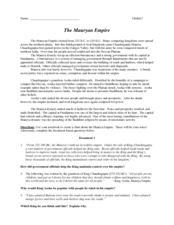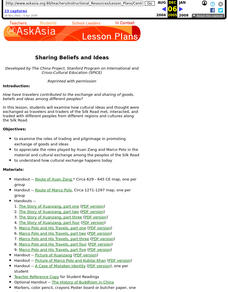Curated OER
Buddhism - Buddha Day, Make Your Own Origami Crane Part 2
In this Origami crane worksheet, learners create an Origami crane from detailed instructions. This crane is an important symbol in the Buddhist religion.
Curated OER
Mandalas
Students explore meditation. In this relaxation and religious studies lesson, students identify reasons for meditation and practice relaxation. Students color a mandala, a richly colored design used as a focal point during Buddhist...
Curated OER
The Teachings of His Holiness: The Dalai Lama - Day 1 of 6
Sixth graders explore philosophy by analyzing the teachings of the Dalai Lama. In this Buddhist history instructional activity, 6th graders analyze a quote from the Dalai Lama and discuss their opinions on his philosophical teachings....
Curated OER
Religion in Southeast Asia: Becoming Familiar with Buddhism Through Jataka Tales
Middle schoolers study basic Buddhist concepts by reading Jataka tales in this unit. They write personal response and identify connections to Buddhist literature and culture.
Curated OER
Buddhism-Buddha Day: Dilemmas Discussion Frame
In this Buddhist belief worksheet, students complete a graphic organizer by identifying 5 everyday dilemmas, considering how they personally handle them, and comparing how Buddhists may deal with them.
Curated OER
The Medium And The Message
Students compare and contrast Buddhist sculpture in varying materials through in-class discussions and small cooperative learning groups. This lesson includes possible lesson extensions.
Curated OER
The Nio
Students discuss the importance of guardian figures in Japanese Buddhist practices using prior knowledge and visual cues gathered from examples of Japanese art. This lesson can be extended to include a creative project.
Curated OER
Religious Intolerance in Afchanistan
High schoolers, as a group, examine and discuss the destruction and planned demolition of Buddhist artifacts in Afghanistan by the Islamic Taliban government. They further research the issue and then hold a simulated summit with...
Curated OER
Iconography: Art and Literature
Learners discover the main subjects and objects of Buddhist art and how symbolism in the Arts can enhance the artistic elements. The lesson concludes with the creation of student works using iconography.
Curated OER
DECODING BOROBUDUR
Students study the example of the spread of Buddhism in Southeast Asia, assess the possible meaning conveyed by Borobudur, explore how ideas travel and the process of syncretism, and appreciate how and why Salindra leaders in Java...
Curated OER
Teaching the Hindu-Buddhist Tradition in East Asian Culture Through Asian Literature and Film
Students explore various intellectual traditions which dominate human history through a variety of contemporary pieces of literature which exemplify the traditions. Biblical monotheism, Greek rationalism, Hinduism, Buddhism, Confucianism...
Curated OER
Understanding Symbols
Students examine two Buddhist images. Using Venn Diagrams, students compare and contrast the images in an effort to decode their meanings. Students are then introduced to Buddhism through a story of Buddha.
Montana State University
One Mountain, Many Cultures
Americans may think of Mount Everest as a region dedicated to adventurous hikers, but many cultures have flourished there! Learners read informative books, watch videos, participate in classroom discussion, analyze folk tales, and...
Curated OER
Religions of Japan
Students explore, analyze and study the religions that originated in Japan, including Shintoism and Zen Buddhism. They assess the beliefs of each religion and compare/contrast all the Eastern Religions and view their people and...
Curated OER
Fall and Winter Religious Celebrations
Students discover the unique beliefs and celebrations of the five major religions in the world. In groups, they discuss the terms associated with each religion and are read books about their celebrations. They create their own dharma...
Curated OER
Japanese Haiku and the American Experience
Twelfth graders research the history to Haiku Poetry. They read classical haiku to comprehend their special sensibility and form. Students encounter the Buddhist philosophical background of this poetry and its roots. They write original...
Curated OER
The Three Doctrines & Legalism
Sixth graders imagine themselves to be, in turn, a follower of Buddhism, Taoism, Confucianism, and Legalism. They are given a handout that lists seven questions. Direct students to write down how they feel an individual would answer...
Curated OER
The Clothing of the Buddha
Young scholars discuss the idea of cultural diffusion by examining how the sculptural portrayal of the Buddha's clothing evolved in Japanese and Chinese art. This lesson concludes with a group project and presentation.
Curated OER
Destruction in Bamiyan
High schoolers examine the destruction of the colossal statues of Buddha, carved into sandstone cliffs of Bamiyan, Afghanistan, that were recently demolished by the Taleban. They look for photos of local artifacts that represent the...
Curated OER
The Mauryan Empire
Create a chart about the Maurayan Empire. Read the provided passage, make a chart, then analyze 3 excerpts. Questions need to be answered for each of the primary source excerpts. Making a reading chart is a good way to take notes!
Curated OER
Maurya & Gupta India
Art, power, and commerce are often the hallmarks of a mighty empire - and the ancient world of India is no exception. The presentation explores the Maurya, Asoka, and Gupta Empires, detailing the territorial and artistic changes that...
Curated OER
Feudal Japan
An excellent overview of historical Japanese culture, this presentation could carry through a world history unit or a lesson on the history of Japan. Especially interesting are the slides that compare Japanese armor and castles to other...
Curated OER
Korea's Literary Tradition
Learners read a text about Korea's literary tradition. In this literary tradition activity, students read the multiple page text to learn about Korea's literary tradition.
Curated OER
Sharing Beliefs and Ideas
Learners examine how cultural ideas and thought were exchanged as travelers and traders of the Silk Road met, interacted, and traded with different peoples from different regions and cultures along the Silk Road.

























